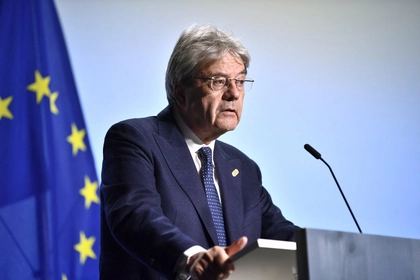The Group of Seven wealthy democracies are likely to have a framework deal for a Russian-asset-backed $50 billion loan to Ukraine by October, in time to tap markets by year-end, European Economic Commissioner Paolo Gentiloni said on Thursday (25 July).
Speaking to reporters on the sidelines of a G20 meeting of finance ministers and central bank governors in Rio de Janeiro, Gentiloni said there was good progress on the technical and legal aspects of the loan, agreed in principle in June.
JOIN US ON TELEGRAM
Follow our coverage of the war on the @Kyivpost_official.
“I think we are making very good progress technically, but also politically. We just had a meeting yesterday towards this extraordinary loan for Ukraine,” he said, referring to a meeting of the G7 ministers before the G20 finance meetings on Thursday.
“I am confident we will be able to have this in place by October. By October I mean the frame. Then, of course, by the end of the year you have to go to markets, but every country is different,” he said.
The $50 billion loan would be serviced with proceeds generated by some $300 billion of Russian central bank assets frozen in the West after Moscow invaded Ukraine in early 2022.
While there is not unanimous support among the G7 to seize the $300 billion of capital, there is agreement it is legally possible to siphon off the profits that assets are generating.
Another G7 source described discussions on the plan as a “detailed and positive” conversation yesterday on the $50 billion loan to Ukraine, adding that there was “shared optimism that all remaining questions can be resolved.”

‘We Are Blocking Propagandists’ – Zelensky Imposes Sanctions on Pro-Russian Politicians
Most of the frozen money, about 210 billion euros ($228 billion), is in Europe. Around $10 billion is in the United States, $10 billion in Britain and some $30 billion in Japan.
That means the bulk of the money to service the loan will come from assets frozen by the EU, which renews its sanctions decision against Russia, including the freezing of the assets, every six months.
The need for frequent renewal of the sanctions has raised concern in the United States as a risk factor for the stability of the revenue stream backing the proposed loan.
Washington has pressed the EU to make its Russian asset freeze less vulnerable to disagreement among the 27 EU governments, granting more legal certainty to bond buyers financing the loan.
The EU is now considering an open-ended agreement on the freezing of the Russian central bank assets, with a change possible during annual reviews only if the Russian aggression ends and there are assurances of compensation by Russia.
Another option could be to extend the current six-month roll-over period for the freeze to 12, 24 or even 36 months.
Any such changes would have to be unanimously accepted by all 27 EU governments, and Hungary, which maintains close ties with Russia, is likely to object.
You can also highlight the text and press Ctrl + Enter










